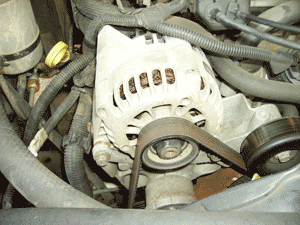Your Vehicles Alternator

A car's battery provides the electric energy necessary for starting, lighting, and ignition; however, the alternator is the true heart of a car's electrical system. The battery provides enough voltage and current to start the engine, but once the engine is started, it is the alternator that produces the power necessary for the electrical system and to recharge the battery.
In the 1960's the alternator replaced its predecessor, the DC generator because of its improved efficiency. It is smaller, lighter, and more dependable than the DC generator. The alternator also produces more output during idle which makes it ideal for late model vehicles.
A vehicle's alternator uses pulleys which usually are spun via a belt that runs off of the engine. These pulleys turn a rotor (magnet) inside of a stator (coils of wire) to produce alternating current (AC) voltage. Rectifiers are then used to convert the alternating current into direct current (DC). Also, a voltage regulator is included to ensure a constant voltage output even when the engine is operating at different RPM [revolution(s) per minute]. Additionally, most alternators include a fan for cooling purposes.
